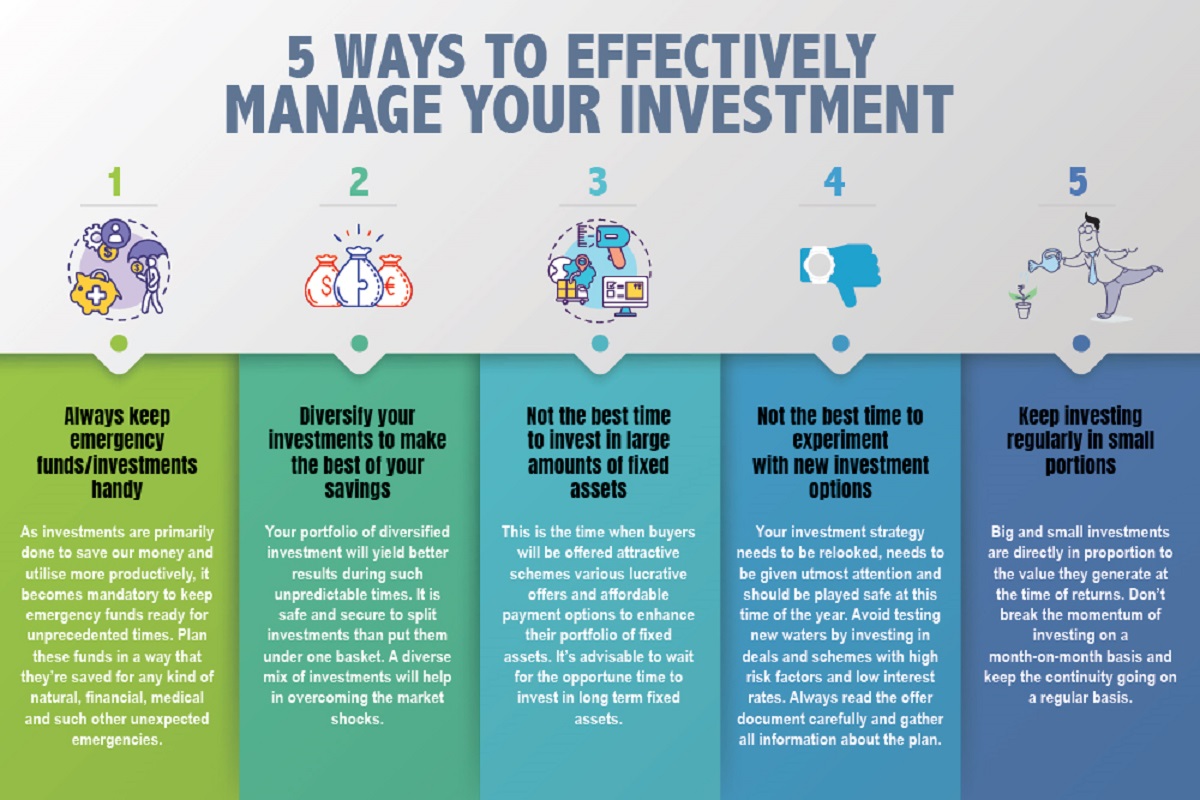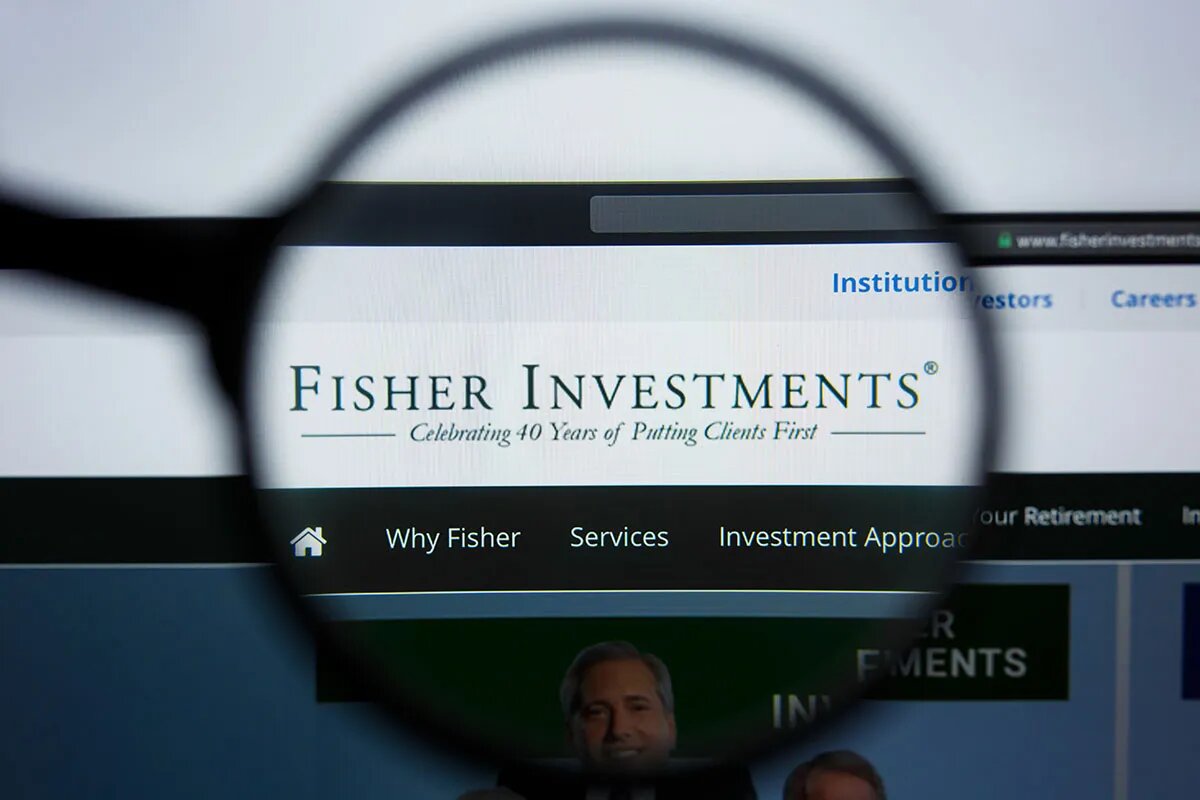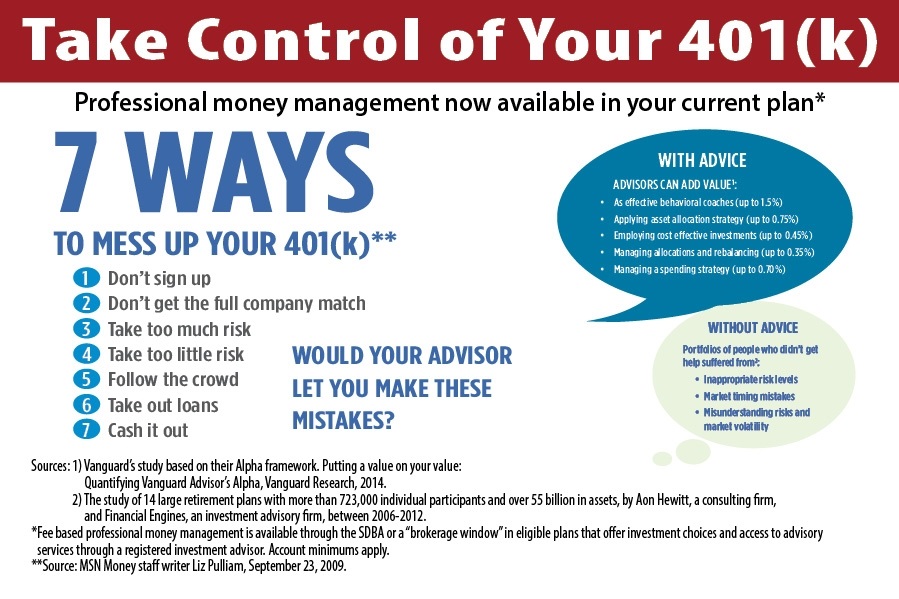Introduction
Welcome to the world of investments! Whether you are a seasoned investor or just starting out, managing your investments effectively is essential for long-term financial success. While it may seem overwhelming at first, with the right knowledge and approach, you can navigate the investment landscape confidently.
Investing your money is a way to grow your wealth and make it work for you. It allows you to potentially earn passive income, preserve capital, and achieve your financial goals. However, it’s important to note that investing comes with risks, and it’s crucial to make informed decisions based on your individual circumstances and goals.
In this guide, we will walk you through the process of managing your investments. We will cover everything from setting financial goals and understanding risk tolerance to diversifying your portfolio and staying informed about market trends. By following these steps and staying proactive, you can enhance your chances of achieving your investment objectives.
Note that investing is a personal journey, and what works for one person might not work for another. It’s important to tailor your investment strategy to your unique needs and circumstances. This guide aims to provide you with a solid foundation to help you get started or refine your existing investment approach.
Remember, investing is a long-term endeavor. It requires patience, discipline, and a commitment to continuously educate yourself about the financial markets. By developing a sound investment plan and staying disciplined, you can pave the way for a secure financial future.
So, let’s embark on this journey together and explore the key factors to consider when managing your investments. Assess your financial goals, understand your risk tolerance, diversify your portfolio, and stay informed. By doing so, you will be equipped with the knowledge and strategies to make well-informed investment decisions.
Assess Your Financial Goals
Before diving into the world of investments, it’s crucial to assess your financial goals. What do you hope to achieve with your investments? Are you saving for retirement, planning for a down payment on a house, or looking to fund your child’s education?
By setting clear and specific financial goals, you can align your investment strategy with your long-term objectives. Take some time to reflect on your goals and prioritize them based on their importance and time horizon. This will help you determine the level of risk you are willing to take and the type of investments that are most suitable for you.
For example, if you have a long-term goal such as retirement that is several decades away, you may be comfortable with higher-risk investments that have the potential for greater returns over time. On the other hand, if you have a short-term goal, such as purchasing a home within the next few years, you may want to focus on more conservative investments that prioritize capital preservation.
It’s important to make your goals specific, measurable, achievable, relevant, and time-bound (SMART). This will provide you with a clear roadmap and enable you to track your progress along the way.
Additionally, consider the importance of building an emergency fund as a part of your financial goals. An emergency fund serves as a safety net and protects you from unexpected expenses or financial setbacks. Aim to set aside three to six months’ worth of living expenses in a liquid and easily accessible account.
Remember, your financial goals may evolve over time, so it’s essential to review and adjust them periodically. Life changes, such as marriage, starting a family, or a career transition, can impact your financial situation and priorities.
By assessing your financial goals, you can establish a clear direction for your investments and make more informed decisions that align with your unique circumstances and aspirations.
Understand Your Risk Tolerance
When it comes to investing, understanding your risk tolerance is crucial. Risk tolerance refers to your ability and willingness to take on risk in your investment portfolio. Every investor has a different comfort level when it comes to risk, and it’s important to align your investment strategy with your risk tolerance.
Before making any investment decisions, take some time to assess how much risk you are willing to take. Consider factors such as your financial situation, time horizon, and personal preferences. Some individuals may be comfortable with a higher level of risk, while others prefer a more conservative approach.
Analyze your financial situation by evaluating your income, expenses, and overall financial stability. If you have a stable job and source of income, you may be more willing to take on higher-risk investments. However, if you have a limited income or higher financial obligations, you may feel more comfortable with lower-risk investments that prioritize capital preservation.
Consider your time horizon, which refers to the length of time you can keep your money invested before needing to access it. Longer time horizons generally allow for a higher tolerance for risk, as there is more time to recover from market fluctuations. If you have a shorter time horizon, you may want to adopt a more conservative investment approach to protect your capital.
Understanding your personal preferences is also important. Some individuals are more risk-averse and prefer stability and predictability in their investments, even if it means potentially lower returns. Others may be more comfortable taking on higher levels of risk in pursuit of greater potential gains.
Keep in mind that risk tolerance is not a static concept and may change over time. It’s important to periodically reassess your risk tolerance and adjust your investment strategy accordingly to ensure it aligns with your evolving goals and circumstances.
It’s worth noting that diversification can be a valuable tool in managing risk. By spreading your investments across different asset classes, sectors, and geographic regions, you can help reduce the potential impact of a single investment’s performance on your overall portfolio.
Understanding your risk tolerance is a fundamental step in managing your investments effectively. By aligning your investment strategy with your risk tolerance, you can strike a balance between potential returns and protecting your capital, leading to a more comfortable and successful investment journey.
Diversify Your Portfolio
One of the most important principles of successful investing is diversification. Diversifying your investment portfolio means spreading your investments across different asset classes, industries, and geographic regions. This strategy is designed to reduce risk by avoiding dependence on a single investment or market.
When you diversify your portfolio, you minimize the impact of any one investment’s performance on your overall portfolio. This is because different types of investments tend to perform differently in various market conditions. By spreading your investments, you have a better chance of capturing gains from different areas of the market while mitigating potential losses.
There are several ways to diversify your portfolio:
- Asset Allocation: Allocate your investments across different asset classes such as stocks, bonds, cash, and real estate. The ideal mix will depend on your risk tolerance and financial goals. Typically, stocks offer higher potential returns but come with higher volatility, while bonds provide stability but have lower returns.
- Sector Diversification: Invest in companies across multiple sectors or industries. This ensures that your portfolio isn’t overly concentrated in any one sector, reducing the risk associated with a sector-specific downturn or negative events affecting a particular industry.
- Geographic Diversification: Invest in companies or funds based in different geographic regions. This helps protect your portfolio from being impacted by the performance of a single country’s economy or events specific to one region.
- Company Size: Consider investing in companies of different sizes, such as large-cap, mid-cap, and small-cap companies. Each category comes with its own risk and return characteristics, and diversifying across these sizes can help balance your portfolio.
- Alternative Assets: Explore investing in alternative assets such as real estate, commodities, or private equity. These assets often have a low correlation with traditional investments, providing further diversification benefits.
Keep in mind that diversification does not guarantee profits or protect against losses, but it does help manage risk effectively. Be sure to regularly review and rebalance your portfolio to maintain the desired asset allocation and ensure your investments remain aligned with your goals.
Working with a financial advisor can be beneficial in creating a well-diversified portfolio that suits your risk tolerance and financial objectives. They can help you assess your investment strategy, provide guidance on diversification, and monitor your portfolio for optimal performance.
Remember, the key to successful investing is not putting all of your eggs in one basket. Diversifying your portfolio is a prudent strategy that can help reduce risk and increase the potential for long-term returns.
Stay Informed About Market Trends
Keeping up with market trends is essential for making informed investment decisions. The financial markets are dynamic and influenced by a variety of factors such as economic indicators, geopolitical events, and industry-specific developments. Staying informed about these trends can help you identify opportunities and mitigate potential risks.
Here are some strategies to help you stay informed:
- Read Financial News: Regularly follow reputable financial news sources to stay updated on market developments, economic trends, and company-specific news. This will provide you with insights into the factors influencing the markets and help you make more informed investment decisions.
- Monitor Economic Indicators: Pay attention to key economic indicators such as GDP growth, inflation rates, employment data, and interest rates. Understanding the broader economic landscape can help you gauge the health of the economy and identify potential investment opportunities or risks.
- Follow Industry Trends: Stay updated on the latest trends and advancements in specific industries that interest you. This knowledge can provide insights into emerging opportunities or potential disruptions that could impact your investments.
- Utilize Investment Tools and Resources: Take advantage of investment tools and resources such as financial websites, market research reports, and investment analysis platforms. These resources can provide valuable data, analysis, and insights to guide your investment decisions.
- Engage in Investor Education: Continuously educate yourself about investing, financial markets, and investment strategies. Attend webinars, seminars, or workshops, or read books written by reputable experts. The more knowledge you acquire, the better equipped you will be to navigate the complexities of the investment landscape.
- Stay Informed About Your Investments: Regularly review and assess the performance of your investments. Monitor company earnings reports, annual statements, and any news or developments related to the companies or funds you have invested in. This information can help you make timely adjustments to your portfolio if necessary.
Remember, while staying informed is important, it’s equally crucial to avoid making impulsive investment decisions based solely on short-term market fluctuations. Maintain a long-term perspective and make investment decisions based on a thorough analysis of the underlying fundamentals and your own financial goals.
Additionally, consider consulting with a financial advisor who can provide you with professional guidance and help you interpret market trends in the context of your specific investment strategy.
By staying informed about market trends, you can make more informed investment decisions, adapt to changing market conditions, and take advantage of potential opportunities that align with your financial goals.
Determine Your Investment Horizon
Understanding your investment horizon is crucial when managing your investments. Your investment horizon refers to the length of time you expect to keep your money invested before needing to access it. It plays a significant role in shaping your investment strategy and determining the appropriate level of risk you can tolerate.
When determining your investment horizon, consider the following factors:
- Short-Term Goals: If you have short-term financial goals that are less than three years away, such as saving for a down payment on a house or planning a vacation, it’s generally recommended to adopt a conservative approach. Focus on low-risk investments that prioritize capital preservation rather than chasing high returns.
- Medium-Term Goals: For goals that are three to ten years away, such as saving for a child’s education or buying a car, you can consider a balanced approach. This means an investment mix that offers some potential for growth but also has a level of stability to protect against market volatility.
- Long-Term Goals: If your goals are more than ten years away, such as saving for retirement, you have a longer investment horizon. This allows you to take on more risk and potentially pursue higher returns by investing in a diversified portfolio of stocks and other growth-oriented assets. Keep in mind that market fluctuations in the short term should not unduly concern you, as you have time to ride out any volatility.
Understanding your investment horizon is important because it helps determine the asset allocation and investment products that are most suitable for you. For short-term goals, focus on stable investments such as high-quality bonds, certificates of deposit (CDs), or money market funds. For longer-term goals, consider a mix of stocks, bonds, and other growth-oriented investments to capture potential returns.
It’s worth noting that your investment horizon may be different for various goals within your overall financial plan. For example, you may have short-term goals like buying a new car and long-term goals like retirement planning. Adjust your investment strategy accordingly for each goal to ensure you have the appropriate risk and return profile.
Remember that your investment horizon can change over time. Reassess your goals periodically and adjust your investment strategy accordingly. Life events, such as a career change, marriage, or the birth of a child, may impact your financial goals and timeframes.
By determining your investment horizon, you can set realistic expectations, align your investment strategy with your goals, and ensure you have the appropriate risk and return profile for your unique circumstances.
Consider Taxes and Fees
When managing your investments, it’s crucial to consider the impact of taxes and fees. These factors can significantly affect your investment returns over time. By understanding and minimizing the tax implications and fees associated with your investments, you can maximize your overall investment performance.
Here are some key considerations regarding taxes and fees:
- Tax-Efficient Investing: Understand the tax implications of your investments and aim to minimize your tax liability. Utilize tax-advantaged accounts such as Individual Retirement Accounts (IRAs) or 401(k) plans to benefit from tax deferrals or potentially tax-free growth. Consider the tax efficiency of different asset classes, such as holding tax-efficient index funds or exchange-traded funds (ETFs).
- Capital Gains and Losses: Be mindful of capital gains and losses resulting from the sale of investments. Capital gains are subject to taxes, so consider strategies such as tax-loss harvesting, where you sell investments that have declined in value to offset gains or reduce taxable income.
- Dividend and Interest Income: Understand the tax treatment of dividend income and interest income from your investments. Certain dividends may be eligible for lower tax rates, while interest income is typically taxed at your regular income tax rate.
- Asset Location: Consider the location of your investments in taxable and tax-advantaged accounts. Generally, investments subject to higher taxes, such as bonds generating interest income, may be more suitable for tax-advantaged accounts. Equities, which typically generate more tax-efficient capital gains and dividends, may be better placed in taxable accounts.
- Investment Fees: Be aware of the fees associated with your investments, such as management fees, expense ratios, or transaction costs. These fees can eat into your returns over time. Compare the fees of different investment options and consider low-cost index funds or ETFs that aim to replicate the performance of a specific market index.
- Asset Turnover: Evaluate the turnover rate of funds or investments you consider. Higher turnover generally leads to more taxable events. Funds with low turnover or a buy-and-hold investment strategy may be more tax-efficient.
Consulting with a tax advisor or financial professional can provide valuable insights into tax-efficient strategies and help you optimize your investment approach based on your tax situation.
Remember, minimizing taxes and fees can have a significant impact on your long-term investment returns. By considering the tax implications of your investments and being mindful of fees, you can increase your overall investment performance and keep more of your hard-earned money working for you.
Monitor Your Investments Regularly
Regularly monitoring your investments is an essential part of effective investment management. This proactive approach allows you to stay informed about the performance of your investments and make necessary adjustments to keep your portfolio aligned with your financial goals and risk tolerance.
Here are some important reasons to monitor your investments regularly:
- Track Performance: Regular monitoring enables you to track the performance of your investments over time. Review the returns and compare them to relevant benchmarks or your own investment objectives. Assessing performance allows you to identify areas of strength and weakness in your portfolio.
- Identify Rebalancing Opportunities: As market conditions change, your asset allocation may drift from your original target. Regular monitoring allows you to identify when your portfolio needs rebalancing. Rebalancing involves adjusting your investments to restore your desired asset allocation, ensuring that you stay on track with your investment strategy.
- Stay Informed About Investing Landscape: Keep up with market trends, economic indicators, and industry developments that may impact your investments. Monitoring helps you stay informed and make informed decisions based on the current investing landscape.
- Assess Risk Exposure: Regularly review your portfolio to assess your risk exposure. Evaluate the diversity of your investments, and ensure you are not overly concentrated in a particular asset class, sector, or geographic region. Adjust your portfolio if necessary to minimize risk and ensure a well-diversified approach.
- Evaluate Investment Costs: Periodically review the fees and expenses associated with your investments. Take note of any changes in costs and assess whether they still align with your investment objectives. Consider whether alternative investments or lower-cost options may better serve your needs.
- Review Life and Financial Goals: As your financial goals or life circumstances evolve, regularly monitor your investments to ensure they align with your changing objectives. Adjust your investment strategy as needed to reflect new goals, risk tolerance, or time horizon.
Balance the need for regular monitoring with avoiding overreaction to short-term market fluctuations. Stay focused on your long-term goals and avoid making impulsive decisions based on temporary market trends.
Automated investment platforms and tools can help simplify the monitoring process by providing real-time updates, performance tracking, and portfolio rebalancing features. Additionally, consider consulting with a financial advisor for professional guidance and a more comprehensive review of your investment portfolio.
Remember, monitoring your investments regularly allows you to stay on top of your investment progress, adjust your strategy as needed, and make informed decisions to optimize your investment outcomes.
Rebalance Your Portfolio
Rebalancing your portfolio is a crucial step in maintaining the desired asset allocation and risk profile of your investments. Over time, market fluctuations and differences in investment performance can cause your portfolio to deviate from its original allocation. By rebalancing, you bring your portfolio back in line with your investment goals and risk tolerance.
Here are key reasons why you should consider rebalancing your portfolio:
- Maintain Asset Allocation: Rebalancing ensures that your portfolio maintains the intended asset allocation you set when you initially constructed it. Over time, certain asset classes may outperform others, causing your portfolio to become overweight or underweight in specific investments. By rebalancing, you sell assets that have become overweight and purchase assets that have become underweight to restore your desired allocation.
- Manage Risk: Rebalancing helps manage risk by preventing your portfolio from becoming too heavily invested in higher-risk assets that may have experienced significant growth. It ensures that your portfolio remains aligned with your risk tolerance, reducing the potential for excessive volatility during market downturns.
- Capture Growth Opportunities: Rebalancing allows you to take advantage of growth opportunities by selling investments that have performed well and reallocating the proceeds to investments that may have lower valuations but greater growth potential. This disciplined approach helps you avoid chasing past performance and enables you to buy low and sell high.
- Discipline and Long-Term Perspective: Rebalancing reinforces discipline and a long-term perspective in your investment approach. It helps you resist the temptation to make emotional decisions based on short-term market fluctuations and keeps your focus aligned with your long-term investment objectives.
- Periodic Review: Rebalancing provides an opportunity for you to review your investment strategy, reassess your goals, and adjust your portfolio if there have been any changes in circumstances or risk tolerance. It ensures that your portfolio remains in line with your evolving financial situation.
When should you rebalance your portfolio? There isn’t a specific timeframe that works for everyone, but a common strategy is to rebalance at regular intervals, such as annually or semi-annually. You can also consider rebalancing when a specific asset class deviates from your target allocation by a certain percentage (e.g., 5% or 10%).
Rebalancing can be done by selling or buying assets within your portfolio or by new investments. You can also use automated investment platforms or work with a financial advisor who can help you determine the appropriate rebalancing strategy based on your goals and risk tolerance.
Remember that rebalancing is a proactive approach to maintaining a well-diversified portfolio. It ensures that your investments stay aligned with your goals, risk tolerance, and changing market conditions.
Seek Professional Advice if Needed
Managing your investments can be a complex and nuanced process. If you feel overwhelmed or unsure about making investment decisions on your own, seeking professional advice can provide valuable guidance and support. A financial advisor or investment professional can help you navigate the intricacies of the investment landscape and ensure that your portfolio aligns with your goals and risk tolerance.
Here are some key reasons to consider seeking professional advice:
- Expertise and Knowledge: Financial advisors possess expertise and knowledge in investment strategy, asset allocation, and financial planning. They can help you evaluate your financial goals, assess your risk tolerance, and develop a personalized investment plan that suits your needs.
- Objective Perspective: A professional advisor can provide an objective perspective on your investments and financial situation. They can help you avoid emotional decision-making and guide you towards making rational and informed choices based on your long-term goals.
- Customized Investment Solutions: Advisors can tailor investment solutions to your specific circumstances. They consider your financial goals, risk tolerance, time horizon, and income level to design an investment strategy that aligns with your unique needs and aspirations.
- Monitoring and Rebalancing: A financial advisor can regularly monitor and rebalance your portfolio on your behalf. They can assess market conditions, track investment performance, and make adjustments to keep your portfolio on track and aligned with your goals.
- Financial Planning: Beyond managing investments, financial advisors can help you create a comprehensive financial plan. They can assist with retirement planning, tax optimization, estate planning, education funding, and other aspects of your financial well-being.
- Behavioral Coaching: Advisors can provide behavioral coaching during market downturns or periods of volatility. They can help you stay disciplined, avoid making impulsive decisions, and maintain a long-term perspective, which is vital for investment success.
When seeking professional advice, it’s essential to choose a reputable and qualified financial advisor. Look for someone who is registered and licensed, and it’s advisable to seek recommendations from trusted sources or conduct thorough research before making a decision.
Remember that seeking professional advice doesn’t mean relinquishing control over your investments. Instead, it empowers you with knowledge, guidance, and support to make more informed decisions and achieve your financial goals.
Whether you choose to manage your investments independently or with the help of a professional advisor, it’s crucial to stay actively involved in your investment journey. Regularly review your portfolio, stay informed about market trends, and reassess your goals as your circumstances evolve. By staying engaged and informed, you can make sound decisions and work towards building a secure financial future.
Conclusion
Managing your investments effectively is crucial for achieving your financial goals and securing your future. By following key principles and strategies, you can navigate the complex world of investing with confidence. Assess your financial goals and risk tolerance, diversify your portfolio, stay informed about market trends, determine your investment horizon, consider taxes and fees, monitor your investments regularly, rebalance when necessary, and seek professional advice if needed.
Remember that investing is a long-term endeavor that requires patience, discipline, and adaptability. Market conditions will fluctuate, and your financial goals may change over time. It’s important to regularly evaluate and adjust your investment strategy to stay aligned with your objectives.
Stay informed about economic trends, industry developments, and market events that may impact your investments. Utilize resources, tools, and professional advice to make informed decisions that align with your unique circumstances and aspirations.
Building a diversified and well-balanced portfolio can help manage risk and maximize potential returns. Regularly monitor your investments, keep track of performance, and make necessary adjustments to stay on course. Rebalance your portfolio periodically to maintain your desired asset allocation and risk profile.
Lastly, remember that seeking professional advice is a valuable option if you feel unsure or overwhelmed. Financial advisors can provide expertise, guidance, and a personalized approach to help optimize your investment strategies and overall financial well-being.
By adopting these practices and maintaining a long-term perspective, you can navigate the ups and downs of the market, make informed investment decisions, and work towards building a secure and prosperous financial future.

























